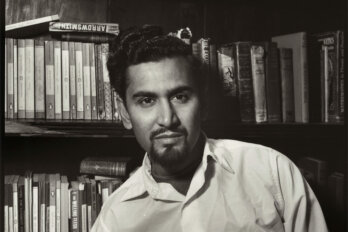Has travel literature died again? Paul Theroux clearly thinks not: his new book, Ghost Train to the Eastern Star, will come out this fall, reprising his identical journey thirty-five years ago and his hugely successful book The Great Railway Bazaar. The irrepressible Rory MacLean’s books (The Oatmeal Ark, Under the Dragon) are enjoying relaunches, with laudatory prefaces from the likes of Jan Morris and William Dalrymple. The eco-travel movement has produced books about human-powered circumnavigation (Colin Angus), travelling only through water or in the trees (Roger Deakin), and walking everywhere.
But two recent books demonstrate, perhaps, that what we carelessly refer to as “travel literature” is, at this moment, a pirogue trapped in a cul-de-sac of a mangrove swamp on an African river — waterways the Victorian writer Mary Kingsley described in her Travels in West Africa as “utter frauds which will ground you within half an hour of your entering them.” Kingsley’s point about the devious complexity of African rivers is that one enters an open, inviting channel with complete confidence and a sure sense of direction, only to find oneself in a dead end, disoriented and confused. Travel literature, a genre all about journeys, has lost its way in the post-colonial era.
Floundering and aimlessness should not surprise us. Travel literature, at least since the travels and writings of Herodotus in the fifth century BC, has always reflected the enthusiasms, optimisms, passions, and predilections of the period in which it was written. Could Mary Wortley Montagu have written her Turkish letters any earlier than the eighteenth century? Could Sir Richard Burton have gotten away with his hubristic disguise as a Pashtun believer (prudently circumcised) sneaking into Medina any later than the 1850s? Could Bruce Chatwin have beguiled us so with Songlines at any other time than the late 1980s? What we now read as classic travel literature is in fact the documentation of very particular periods of colonialism and empire building, the records of well-funded, well-educated aristocrats and grandees, charging up and down the rivers of Africa, across the Arctic, and down to Antarctica, looking for cities (Timbuktu), routes (the Northwest Passage), and sources (the Niger and the Nile), as well as particular botanical specimens. Travel literature was about mapping and charting the unknown; explorers saw everything as virgin territory, to be baptized with the names of sponsors and loved ones. Not coincidentally, while writing beautifully they were also laying the ground for commercial exploitation and political dominance.
Since the 1960s, the explosive politics of Asia and Africa and revolutions in Eastern Europe have nurtured a rich tradition of literary reportage (highbrow, expository travel literature) by the likes of Robert Kaplan, Ryszard Kapuscinski, and Isabel Hilton. And the dilettantish renaissance in the 1980s — the obsessively romantic and man-alone exploits of such writers as Theroux, Chatwin, and Jonathan Raban, and the success of publications like Granta — reflected a fin de siècle exuberance that was blown out like a candle in September 2001.
The heroic is no longer compelling. There are few places under the sun that cannot be found with the help of global positioning technology (which is how the source of the Amazon was finally confirmed in 2000). Almost anyone can get to the top of a remote glacier and send a photo home via satellite phone. Travel, and travel literature, used to be about being the first person to do or see something; it is increasingly about being the last to chronicle a shrinking wilderness or witness a creature facing extinction. And in a world in which exodus and exile are the journeys that matter — Zimbabweans swimming across the Limpopo to South Africa, Somalis fleeing to Yemen, Burmese refugee camps in the borderlands of Thailand — the great white perspective on the exotic seems irrelevant, even insulting.
And this malaise is deepened by the great debate, still, among writers and critics, about the use of fiction and its techniques in the writing of what purists insist must be a literal, linear truth: no combining of journeys into a single compelling narrative, no turning of real people into composite characters, no dialogue that is not diligently transcribed and therefore checkable, no excision of the boring and the mundane, and certainly no flights of magic realism. But despite its banner-flying history as fearless exploration, travel writing has always been rooted in the outside culture’s self-regard and imagination, has always had more than a whiff of fantasy about it, which is why the best travel literature is often written by novelists and poets, whose very craft is about making something greater and more thrilling than its parts.
Two books exemplifying the pirogue becalmed in the mangroves are by two great recent practitioners of the form: the Polish writer Ryszard Kapuscinski, who died in 2007, and the Belgian writer Lieve Joris.
Travels with Herodotus is the most recent Kapuscinski book translated into English, and it is more of a memoir and a meditation than a piece of travel literature. After the compelling opening chapters, describing the author’s transformation from a naive and incoherent young reporter (wearing a yellow nylon shirt and “massive loafers”) into a foreign correspondent in India and China, the book is largely a meandering engagement with the writings of Herodotus, the Greek “father of history” — Kapuscinski would call him a writer of investigations — whose book The Histories was a gift to Kapuscinski from his first editor.
Kapuscinski is concerned with the “why” of reportage, for which he takes Herodotus as a model, his teacher: “To prevent the traces of human events from being erased by time,” because Herodotus was “obsessed with memory . . . it is what elevates man above beasts.” He teases out Herodotus’s fascination with war in a world that was “a bright Arcadia which every few years overflows with blood.” Only the frequency (and the size of the world) has changed; Kapuscinski famously claimed to have covered more than twenty-seven coups and revolutions as a reporter, in close to twenty-five books, fewer than half of which have been translated into English.
For vintage Kapuscinski — and his books can be difficult to find — look to the twentieth volume in Penguin’s Great Journeys series. A selection called “The Cobra’s Heart” is taken from his controversial 2001 book, The Shadow of the Sun. His form has always been the weightier, more complex version of travel literature known as literary reportage, but even that is an inaccurate description of his writing. Although he earned a living for nineteen years as a correspondent for the Polish Press Agency, his books are narratives based on recalled experiences, not reporting.
The Shadow of the Sun covers some thirty years of work in Africa, and the controversy that tags Kapuscinski concerns charges of inaccuracy, fabrication, racism, and the recent suggestion that he was an agent for the Polish secret police. “The Cobra’s Heart,” in which the author drives through a herd of a thousand buffalo, kills a cobra, and almost dies from cerebral malaria on his way to a coup in Uganda, is an unsettling coil of exceptionally vivid writing, deep empathy for the poor, and an undertow of Eurocentrism:
The locals. How they fit this landscape, this light, these smells. How they are as one with them. How man and environment are bound . . . how firmly each race is grounded in the terrain in which it lives, in its climate . . . Among these palm trees and vines, in this bush and jungle, the white man is a sort of outlandish intruder. Pale, weak, his shirt drenched with sweat, his hair pasted down on his head, he is continually tormented by thirst and feels impotent, melancholic . . . With their strength, grace, and endurance, the indigenous move about naturally, freely, at a tempo determined by climate and tradition, somewhat languid, unhurried . . .
In Travels with Herodotus, Kapuscinski paraphrases and quotes long passages from The Histories, as if to prevent the traces of his ancient mentor’s writing from being erased. And with the subtlety of a master craftsman, he uses these passages and his musings on the character and life story of Herodotus to lead the reader toward a portrait of Kapuscinski himself, the restless chronicler:
Creatures like him are insatiable, sponge-like organisms, absorbing everything easily and just as easily parting with it. They do not keep anything inside for long . . . they constantly need to ingest something new, replenish themselves, multiply, augment. Herodotus’s mind is incapable of stopping at one event or one country. Something always propels him forward, drives him on without rest.A fact that he discovered today no longer fascinates him tomorrow and so he must walk (or ride) elsewhere, further away . . . A vivacious, fascinated, unflagging nomad, full of plans, ideas, theories. Always traveling. Even at home (but, where is his home?) he has either just returned from an expedition or is preparing for the next one. Travel is his vital exertion, his self-justification is the delving into, the struggle to learn — about life, the world, perhaps ultimately himself.
Why does this quiet book speak to a sense of stasis in the tradition of travel writing? Because it is an epitaph for the exemplar of a tradition, a style, a persona that is already anachronistic. Kapuscinski was the product of his time and place — a poet, an intellectual, a highly imaginative writer whose book about Ethiopian dictator Haile Selassie (The Emperor), ostensibly a piece of literary reportage, was widely read as an allegory about Polish communism. By letting it be known that he always carried two notebooks, Kapuscinski signals the distinction between reporting and writing — the latter a free play of fact, fantasy, and interpretation. Also, his journeys were not those of a stranger, a naïf, a writer like Theroux or Raban, whose travels and observations tend to be more about themselves than about their subject. Kapuscinski had the street cred of the intrepid war correspondent, which gave his literary reportage a rare authority, and he wrote so beautifully that the reader was able to say, ah yes, so that is what Africa is.
But readers have become chary of that kind of authority, which comes from being both the outsider and the erudite observer, from being one who benefits from the intimacy of long periods in a country and returns to it. Like the aristocratic Victorian explorers, Kapuscinski is a kind of museum piece, a reminder of an era less concerned with, and constrained by, the ethics of a white European directing his gaze and imagination on Africa.
Lieve Joris is a Belgian travel writer living in Amsterdam whose books are infrequently translated into English. One of her best is Mali Blues: Traveling to an African Beat, published by Lonely Planet in 1998 (and currently out of print). It consists of four tales of travel in Senegal, Mauritania, and Mali, the last and longest of which is a portrait of the Malian blues singer Boubacar Traoré, known as Kar Kar.
In this brilliant, intriguing piece, Joris — from her first meeting with a suspicious, grumpy Kar Kar until their last, affectionate exchange after a visit to his wife’s grave — draws the reader into an intimate, almost erotic portrait of a charismatic and enormously popular artist with a complicated life story. In one sense, it is clear this is Kar Kar’s journey, not hers, that she is literally along for the ride on the “junk heap” buses, the train, pickup truck, and motorbike, and on foot. On her first visit to his house, she observes Kar Kar kneeling in prayer: “He rolls out a sheepskin rug and turns to face Mecca. When he bends over I see that he’s wearing three leather thongs around his thighs. Gris-gris [amulets]. I look the other way in embarrassment.”
Joris insinuates herself into Kar Kar’slife, travelling with him to his birthplace in Kayes; to Sansanding, the distant village where he goes to consult a marabout (a Muslim holy man), who gives him amulets, ointment, and herbs; and finally to the village of Bandiagara, where she is rewarded with the story of his wife’s death, which he has been withholding from her. She is always the scribe, but also the “foreign woman” with Kar; people gossip, saying they are staying together at the hotel. They eat and sleep in proximity, they tease and flirt with each other. He speaks of unreliable, fickle foreigners, and Africans doing bad things to Africans, shows her the crumbling legacy of the French occupation, and introduces her to his extended family. In Bandiagara, in a clay house, late in the evening:
Anta has brought a pail of water to the shower and waves to me that I can go in. While I stand pouring cups of water over myself in the soft light of the moon, I suddenly realize that the wall facing the street is so low that I’m standing half-naked in the middle of the village. I think of the young men who walked us to the door, and am thankful that I haven’t come here as a tourist, that I belong with the people sitting out there in the courtyard.
In Mali Blues, Joris achieves a precise balance of voice and presence; she is not only crafting a story, it’s a story we would never hear were she not so close. She is like a photographer who never lets her subject out of the frame, yet she sleeps on the mat Kar rolls out for her, and “Kar, Maciré, and I eat from the same enamel bowl and use a fan to shoo away the flies.”
But Joris’s new book, The Rebels’ Hour — her third about Congo, where her uncle was a missionary during the Belgian occupation — seems symptomatic of a failure of conviction, a valiant, often compelling attempt to transform material that might have been travel literature or reportage into something else again. It is the story of Assani, a boy from the high plains of eastern Congo who becomes a leader in the guerrilla Tutsi movement led by Joseph Kabila. The book alternates between past (1967 to the late 1990s) and present (Kinshasa in 2003–2004). We follow Assani, who loves his mother and does not know his father, who hungers for learning and a sense of belonging, who is transformed from a herder of cattle into a powerful, wealthy commander surrounded by a cadre of kadogos (boy soldiers), a leaderwho trusts no one and is forced to deal with corruption and lapses in discipline:
[One of his soldiers] told him how they’d tricked the fleeing inhabitants. They grabbed a boy and ordered him to shout ‘Amani !’ Peace! It was an old tactic used by Rwandans and Burundians, but people here were so isolated that they’d fallen for it and left their hiding places, glad it was all over and they could get back home before their meager possessions were stolen. They lined the streets, several rows deep, looking expectantly at the soldiers, who started shooting at random.
When The Rebels’ Hour was first published in Flemish in 2006, it was as non-fiction; in France, it was sold as a work of fiction; and now the English translation features an enigmatic prefatory note: “This book is based on real characters, situations and places, without ever coinciding with them completely.” Joris admits in the foreword that she tracked the man upon whom she based Assani for more than six years, from near and from afar, and that while “the facts are true, I’ve had to fill in some parts of [my characters’] lives from my own imagination.”
This playing with the genre and use of fiction techniques are not what makes the book problematic (Joris is up front, not devious); it is rather the absence, the erasure, the silence of Joris. Through the course of this complex, troubling narrative, her eye, her nose, her ear, and her voice are not there to guide the reader. There is only a stand-in named Claudine, a Belgian restaurant owner who travels back and forth between Europe and Africa, and speaks with Assani on the phone. Joris has spoken about the challenge of form; clearly it would have been impossible for her to write the story of Assani as she wrote the story of Kar, by comparison now a naive, folkloric tale. In The Rebels’ Hour, she writes, “To tell the story I’d watched unfold in the shadows, I had to venture deeper into the subterranean depths of my characters than I’d ever done before. Only after I withdrew behind the walls of a monastery near the Belgian city of Bruges did the material finally yield itself up.”
Joris made an unequivocal choice in this book to banish the “I” from her narrative. Ironically, this perspective, which now generates moral discomfort in Western readers, is exactly what the piece needs to work; without it, the reader is set adrift. Curiously, infuriatingly, we do not feel that way if we know a work to be fiction, where both the writer and the reader are released from the need for veracity.
I’m sure this ambivalence is rooted in some atavistic fear of being tricked and killed; we are very, very afraid of the Trojan Horse. We live in a time when ambiguity, and especially moral ambiguity, is suspect; there is, perhaps, a collective fear of being wrong, of being ambushed. And so, for now, the very thing that gives great travel literature form and credence — the grounding subjectivity of the author’s eyes, ears, nose, and voice — is considered unreliable. But what we lose for the sake of our moral scruples is Kapuscinski’s “vivacious, fascinated, unflagging nomad, full of plans, ideas, theories” — human life as seen from inside the messiness of that mangrove swamp on an African river, disoriented and confused.






